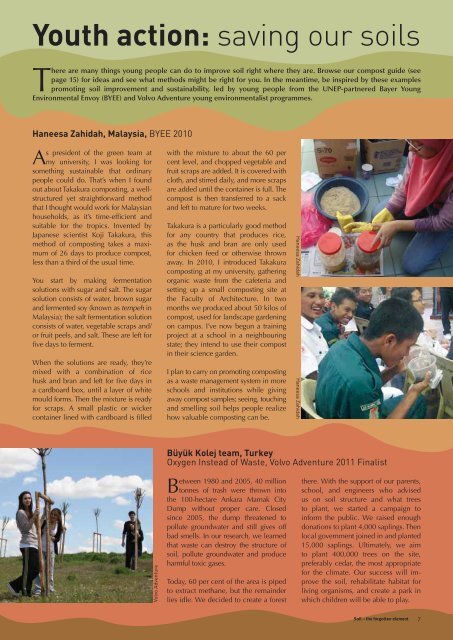Tunza Vol. 9.2: Soil - the forgotten element - UNEP
Tunza Vol. 9.2: Soil - the forgotten element - UNEP
Tunza Vol. 9.2: Soil - the forgotten element - UNEP
Create successful ePaper yourself
Turn your PDF publications into a flip-book with our unique Google optimized e-Paper software.
Youth action: saving our soils<br />
There are many things young people can do to improve soil right where <strong>the</strong>y are. Browse our compost guide (see<br />
page 15) for ideas and see what methods might be right for you. In <strong>the</strong> meantime, be inspired by <strong>the</strong>se examples<br />
promoting soil improvement and sustainability, led by young people from <strong>the</strong> <strong>UNEP</strong>-partnered Bayer Young<br />
Environmental Envoy (BYEE) and <strong>Vol</strong>vo Adventure young environmentalist programmes.<br />
Haneesa Zahidah, Malaysia, BYEE 2010<br />
As president of <strong>the</strong> green team at<br />
my university, I was looking for<br />
something sustainable that ordinary<br />
people could do. That’s when I found<br />
out about Takakura composting, a wellstructured<br />
yet straightforward method<br />
that I thought would work for Malaysian<br />
households, as it’s time-efficient and<br />
suitable for <strong>the</strong> tropics. Invented by<br />
Japanese scientist Koji Takakura, this<br />
method of composting takes a maximum<br />
of 26 days to produce compost,<br />
less than a third of <strong>the</strong> usual time.<br />
You start by making fermentation<br />
solutions with sugar and salt. The sugar<br />
solution consists of water, brown sugar<br />
and fermented soy (known as tempeh in<br />
Malaysia); <strong>the</strong> salt fermentation solution<br />
consists of water, vegetable scraps and/<br />
or fruit peels, and salt. These are left for<br />
five days to ferment.<br />
When <strong>the</strong> solutions are ready, <strong>the</strong>y’re<br />
mixed with a combination of rice<br />
husk and bran and left for five days in<br />
a cardboard box, until a layer of white<br />
mould forms. Then <strong>the</strong> mixture is ready<br />
for scraps. A small plastic or wicker<br />
container lined with cardboard is filled<br />
with <strong>the</strong> mixture to about <strong>the</strong> 60 per<br />
cent level, and chopped vegetable and<br />
fruit scraps are added. It is covered with<br />
cloth, and stirred daily, and more scraps<br />
are added until <strong>the</strong> container is full. The<br />
compost is <strong>the</strong>n transferred to a sack<br />
and left to mature for two weeks.<br />
Takakura is a particularly good method<br />
for any country that produces rice,<br />
as <strong>the</strong> husk and bran are only used<br />
for chicken feed or o<strong>the</strong>rwise thrown<br />
away. In 2010, I introduced Takakura<br />
composting at my uni versity, ga<strong>the</strong>ring<br />
organic waste from <strong>the</strong> cafeteria and<br />
setting up a small composting site at<br />
<strong>the</strong> Faculty of Architecture. In two<br />
months we pro duced about 50 kilos of<br />
compost, used for landscape gardening<br />
on campus. I’ve now begun a training<br />
project at a school in a neighbouring<br />
state; <strong>the</strong>y intend to use <strong>the</strong>ir compost<br />
in <strong>the</strong>ir science garden.<br />
I plan to carry on promoting com post ing<br />
as a waste management system in more<br />
schools and institutions while giving<br />
away compost samples; seeing, touching<br />
and smelling soil helps people realize<br />
how valuable composting can be.<br />
Haneesa Zahidah Haneesa Zahidah<br />
<strong>Vol</strong>vo Adventure<br />
Büyük Kolej team, Turkey<br />
Oxygen Instead of Waste, <strong>Vol</strong>vo Adventure 2011 Finalist<br />
Between 1980 and 2005, 40 million<br />
tonnes of trash were thrown into<br />
<strong>the</strong> 100-hectare Ankara Mamak City<br />
Dump without proper care. Closed<br />
since 2005, <strong>the</strong> dump threatened to<br />
pollute groundwater and still gives off<br />
bad smells. In our research, we learned<br />
that waste can destroy <strong>the</strong> structure of<br />
soil, pollute groundwater and produce<br />
harmful toxic gases.<br />
Today, 60 per cent of <strong>the</strong> area is piped<br />
to extract methane, but <strong>the</strong> remainder<br />
lies idle. We decided to create a forest<br />
<strong>the</strong>re. With <strong>the</strong> support of our parents,<br />
school, and engineers who advised<br />
us on soil structure and what trees<br />
to plant, we started a campaign to<br />
inform <strong>the</strong> public. We raised enough<br />
donations to plant 4,000 saplings. Then<br />
local government joined in and planted<br />
15,000 saplings. Ultimately, we aim<br />
to plant 400,000 trees on <strong>the</strong> site,<br />
preferably cedar, <strong>the</strong> most appropriate<br />
for <strong>the</strong> climate. Our success will improve<br />
<strong>the</strong> soil, rehabilitate habitat for<br />
living organisms, and create a park in<br />
which children will be able to play.<br />
<strong>Soil</strong> – <strong>the</strong> <strong>forgotten</strong> <strong>element</strong><br />
7
















